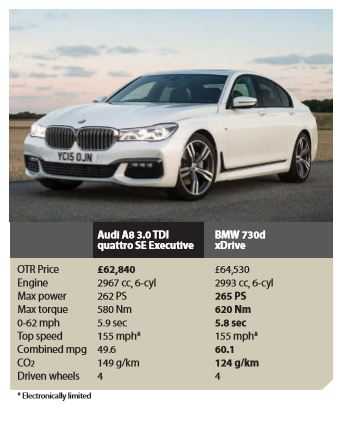BMW 7 Series versus Audi A8
BMW is celeBrating its centenary this year, although it hasn’t been making cars for all that time, having started as an aero engine manufacturer. Motor cycles were next and cars followed when BMW purchased Fahrzeugfabric eisenach which had been making austin 7s under licence, under the Dixi brand. The first real BMW was the 328 in 1936. Unfortunately, during the war, BMW stopped making cars and didn’t start again until 1951 with the large four-door 501, a very rare beast today. The fabulous 507 sports car followed, which is now both rare and very valuable. BMW was all but bankrupt in 1958 and was saved by the purchase of the rights to build the iso isetta and, in 1959 investment by the Quandt family which still owns 46 per cent of the company. audi in its various forms went through similar trials over the years, but both companies are now very healthy indeed. Who would have thought that BMW’s Dna consisted of austin sevens and bubble cars! Having concentrated on small cars through the 1950s and 60s, BMW finally made a large car again in 1969, the beautifully styled 2500. The seven series followed in 1977 but it would be another 17 years until audi launched the a8. if Ferdinand Piëch hadn’t been so determined to pioneer volume aluminium construction, it would have been sooner. There had been audi 200s and even the V8, but they didn’t cut it against the 7 series and Mercedes s-class. The audi a8 was uprated in 2014 and the sixth generation 7 series in late 2015, so for once it is a perfect comparison as opposed to comparing an old technology car with a new technology competitor.

These cars, along with the s class Mercedes, are technological masterpieces. i remember, at the launch of a previous a8, sitting in a car while the a8 product manager spent two hours explaining what the car could do; it would probably take three hours with the latest car. i was absolutely amazed and i doubt whether many owners utilise more than 10 per cent of the facilities available in such cars. Both brands offer a range of engines in their luxury rangetoppers, the 7 series with two petrol engines: 326 and 449 Ps and two diesels: 265 and 320 Ps. There is also a hybrid. The 7 series is eclipsed in the power stakes by the a8 with two petrol units: 520 Ps in the s8 and 600 in the W12. There are two diesels: 262 and 385 Ps but no hybrid, currently. needless to say, all are automatics. BMW’s diesels are completely new and highly efficient, the rear-wheel-drive 730d having a remarkable claimed combined economy of 60.1 mpg and cO2 of just 124 g/km. For the a8 3.0 tDi quattro, the claims are 49.6 mpg and 149 g/km. Finally, BMW has made the 7 series available with four-wheel drive in the UK, although most 7 series are probably two-wheeldrive 730d models bought by chauffeur companies without which the big german limos would probably not exist. The predominance of chauffeur-company buyers might also explain why audi doesn’t fit the fabulous 320 Ps BitDi engine in the a6; the chauffeurs don’t need the extra power. its chauffeur customers would probably prefer a two-wheel drive a8 for lower cost and better economy. BMW has taken a rather different approach to weight reduction. as opposed to all-aluminium in the a8, BMW takes a multi-material approach in the construction of the body, including carbon-fibre reinforced plastic (cFrP), ultra-high-tensile steels and aluminium which increases the strength and rigidity of the passenger cell while also bringing about a substantial reduction in vehicle weight. Despite the new 7 series weighing 130 kg less than its predecessor, it still can’t quite match the a8 which is 20 kg lighter. BMW has really bolstered its green credentials with careful material selection, energy-efficient production processes and further improved arrangements for environmentally- friendly recycling allowing the new BMW 7 series to obtain an exemplary life cycle assessment covering its entire product life. The environmental impact, the ‘greenhouse potential’, is around 25 per cent lower than in the outgoing model. These cars are, as you would expect, exquisitely built and BMW has finally matched audi’s peerless interior quality. now that BMW has made all-wheel drive available, you can’t slip a cigarette paper between these two. Mind you, if you want power and are not worried about cost or the environment it would have to be the audi s8 or W12. The best handling car, on a dry day would be the rearwheel-drive 7 series which, despite its size, is great fun to drive!
